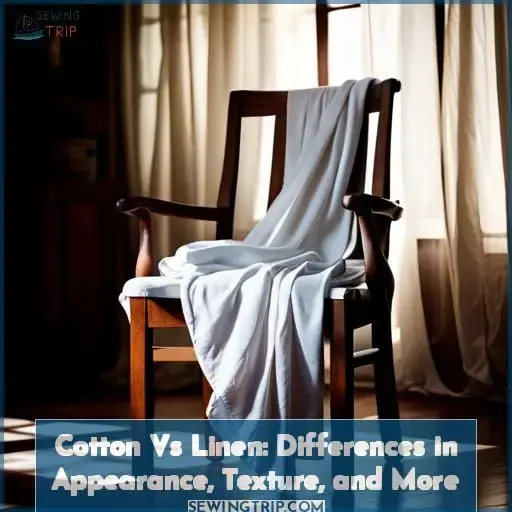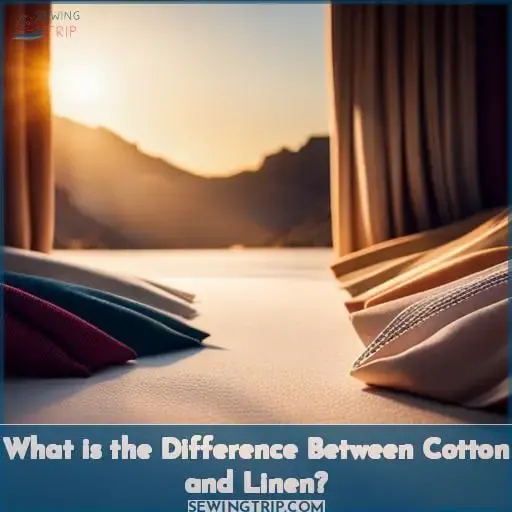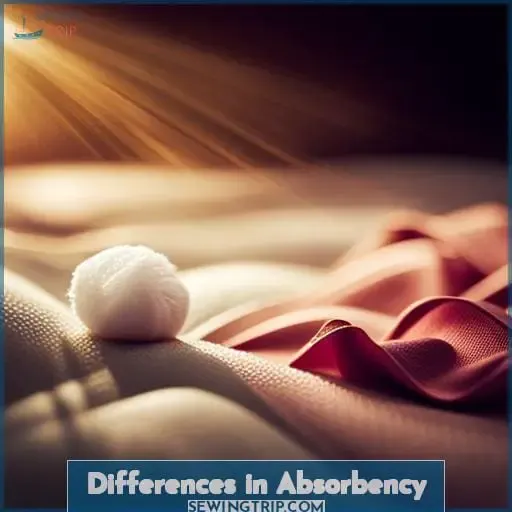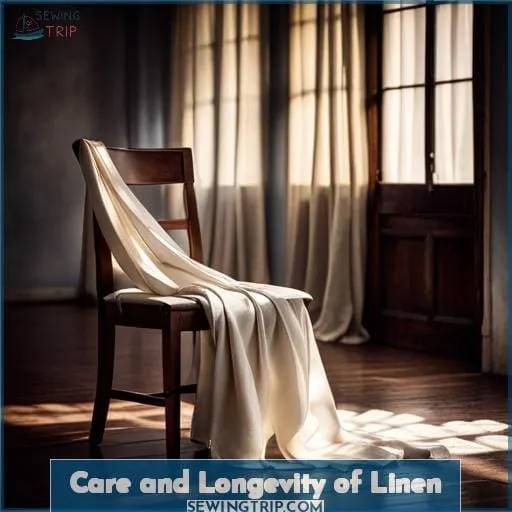This site is supported by our readers. We may earn a commission, at no cost to you, if you purchase through links.
 Are you curious about the differences between cotton and linen? As two of the most popular fabric choices for luxury bedding, these materials have subtle distinctions that might make one more suitable than the other.
Are you curious about the differences between cotton and linen? As two of the most popular fabric choices for luxury bedding, these materials have subtle distinctions that might make one more suitable than the other.
Before choosing which type to go with, let’s dive into what makes them unique and explore their appearance, texture, breathability and warmth as well as absorbency. In addition to this overview of their characteristics, we’ll also look at how each fares in terms of fashion and care and longevity.
Table Of Contents
Key Takeaways
- Cotton is soft and breathable, while linen is strong and has moisture-wicking properties.
- Linen provides better ventilation and cooling than cotton in warm weather. Linen also has thermoregulating capabilities that keep you warm in winter yet cool in summer.
- Cotton is extremely versatile for clothing and home goods. Linen is better suited for warmer climates and special occasions.
- The durability and eco-friendliness of linen make it a worthwhile long-term investment compared to cotton.
What is the Difference Between Cotton and Linen?
You’re interested in learning about the differences between cotton and linen. Cotton is known for its softness and breathability, making it a versatile fabric for clothing and home goods, while linen stands out for its durability, moisture-wicking properties, and natural luster, ideal for warmer climates and special occasions.
The two natural fibers have distinct characteristics that make them suitable for different uses.
Cotton is a soft, fluffy fiber that grows in a boll around the seeds of cotton plants. Its comfort and ability to let air flow through fabric makes cotton well-suited for items like t-shirts, underwear, sheets, and lightweight summer clothing.
Cotton absorbs moisture well, but can wrinkle easily. It’s also prone to shrinkage, so cotton garments and household items often need extra care when laundering.
Linen is made from the fibers of the flax plant and has a smooth, crisp feel. It is stronger and more durable than cotton, resistant to abrasion, and can hold its shape well over time. Linen excels at absorbing moisture, drying quickly, and keeping wearers cool in hot weather.
Its tendency to wrinkle gives linen a casual, rumpled look. While not as soft as cotton initially, linen becomes suppler with washing and wear. Linen works well for clothing like lightweight suits and dresses, as well as tablecloths, towels, and other home goods meant to withstand frequent use and laundering.
So in summary, cotton is softer, more breathable, and versatile for everyday use, while linen is stronger, dries faster, and suits warmer weather or special occasions. Considering the different characteristics of each natural fiber can help guide choices between cotton and linen products.
Characteristics and Uses of Cotton
Cotton’s soft yet durable fibers work well year-round, easily layered for warmth or gossamer light in summer. Cotton’s natural breathability keeps you cool in summer while retaining warmth in winter. Its moisture-wicking and quick-drying properties draw sweat from your skin. Cotton’s versatility allows it to be spun into any thickness—from sheer voiles to sturdy denims.
Known for its comfort and affordability, cotton comprises over 50% of all textiles produced globally. However, conventional cotton demands immense water and chemical inputs, spurring more sustainable production methods.
Improved cotton responsibly blends durability, breathability and easy care to suit your lifestyle needs. With proper care, cotton’s longevity reduces textile waste for a smaller footprint.
Characteristics and Uses of Linen
Having breathable, thermoregulating, and hypoallergenic properties ideal for fashionable summer wear, linen offers a responsible choice for environmentally-friendly apparel.
From woven flax fibers and available in three versatile fabric types, linen provides durability compared to cotton while sustaining its texture with proper care.
The longevity and comfort of linen stem from its breathability, quick drying nature, and resistance to stretching due to the flax fibers’ strength.
Softening over time and washes, linen becomes irresistibly luxurious – the fabric gains character, drape, and luster.
Choosing linen supports responsible production methods and longevity in your wardrobe.
With proper knowledge of linen types and care, you can cherish those breezy linen pieces for seasons to come.
Differences in Appearance and Texture
When exploring the differences between cotton and linen, pay close attention to appearance and texture. Both natural fibers have a soft, breathable feel, but linen’s character comes from its visible slubs and structured drape, while cotton has a smooth, consistent surface and flows more freely.
Appearance
Though similar at first glance, linen’s natural slubby texture and matte finish set it apart from cotton’s consistently smooth, soft hand.
- Linen maintains its natural irregularity and texture, while cotton offers consistent softness.
- Linen has more of a matte, textured look compared to cotton’s sheen and silkiness.
- Cotton fibers have a rounder shape than the flat, complex linen fibers that create slubs.
The unique characteristics of linen’s raw texture from the flax plant give it an earthier, organic aesthetic contrasted with cotton’s refined and consistent appearance. Their inherent differences in origin are reflected in the fabrics: linen echoes its natural source, while cotton aims for uniformity.
Texture
Despite their stark differences, linen’s unique texture makes cotton feel like sandpaper in comparison. When it comes to tactile sensation, linen stands out for its smooth feel and fabric quality. The sensory experience of 100% linen bed sheets is like none other – a buttery, silken texture that improves with age and washing.
Though cotton may boast a higher thread count, linen’s natural fibers weave a textural tapestry beyond thread numbers. Its cloth caresses skin, providing a gentle embrace compared to cotton’s coarser grains.
This textile comparison shows linen as the clear winner for ultimate comfort and quality.
Differences in Breathability and Warmth
As an expert in textile manufacturing, I can explain the differences in breathability and warmth between cotton and linen. Both cotton and linen are natural fibers that allow your skin to breathe; however, linen is more durable, dries quicker, and is actually thermoregulating, helping to keep you cool when it’s hot yet providing warmth when it’s cold.
Because linen is made from the flax plant, it naturally absorbs moisture well, moving it away from your skin.
Breathability
You’ll find linen more breathable than cotton in warm weather. Linen’s natural fibers create a looser weave that allows more airflow than cotton’s finer weave. This breathability makes linen ideal for warm climates and summer wear. The flax fibers absorb moisture better, carrying sweat away from your skin.
Cotton tends to cling when damp. Linen’s superior breathability helps regulate your temperature. Its moisture-wicking and quick-drying properties keep you cool in the heat. Cotton’s breathability still works for layering through seasons.
But for true cooling comfort, linen is unmatched. Its natural fibers thermoregulate in heat and cold.
Warmth
Didn’t they tell you linen’s thermoregulating properties can keep you cool in summer yet warm in winter?
- Mesmerizing moisture-wicking action pulls heat from skin.
- Lightweight weave promotes air circulation around you.
- Natural fibers regulate body temperature.
- Surprisingly warm despite open, breathable texture.
- Adapts to climate so you stay comfortable.
It’s amazing how the flax plant’s fibers gift us that breathable linen magic. Wicking moisture yet retaining warmth is linen’s forte. This natural fabric adapts its insulating abilities to the seasons better than cotton.
Differences in Absorbency
Cotton’s natural absorbency makes it adept at drawing in moisture, able to absorb up to 25% of its own weight. The fluffy fibers act like little straws, pulling liquid in. This absorbency makes cotton an ideal choice for towels, t-shirts, bedsheets and other everyday textiles where it can soak up perspiration.
Linen’s smooth surface resists absorbing moisture. The fibers of the flax plant only take in about 20% moisture. But linen makes up for this with its quick evaporation, drawing sweat off your skin. For items like swimsuits or athletic wear where you want moisture wicked away, linen wins.
So consider the purpose when choosing absorbent cotton or quick-drying linen. Absorbency factors into utility.
Which is Better for Fashion?
Let’s see cotton’s popularity in casual fashion while linen’s sophistication suits formalwear. Cotton’s soft, breathable feel makes it a staple for t-shirts, jeans, sweats, and loungewear. The casual comfort of cotton dresses it down. Linen’s elegant drape and lightweight structure lend sophistication.
From linen button-downs to trousers, it excels in tailored fits. Crisp linen conveys class. Its wrinkled texture adds depth. Linen jackets project prestige. Flowy linen dresses and skirts feel feminine.
Linen suits radiate refinement. Still, both have roles. Choose easy cotton for play, and linen’s grace for formal affairs. Consider occasion and style goals when deciding between these timeless natural fibers.
Care and Longevity of Linen
Linen requires gentle care to last decades, unlike cotton’s simpler wash-and-wear ease. Though the natural fabric needs more mindfulness, its strength and heritage persist from ancient artisans to sustain future fashions.
How to Care for Linen
Wash your linen in cold water with a gentle detergent; never use bleach. Dry it on low heat to preserve the natural texture. Treat your linen clothing carefully to maximize longevity – folding rather than hanging reduces wrinkling, and line-drying when possible maintains the fabric’s breathability.
For tablecloths or sheets, occasionally washing delicately and tumble drying on low heat refreshes the fibers; iron while still slightly damp if needed. With proper care, linen’s natural durability ensures it only softens and improves with use.
Pros and Cons of Linen
Though linen is prone to wrinkling, its durability withstands the test of time. Despite creases from handling, linen holds up better than cotton over the years – all while being gentler on skin and the planet.
Made from flax, linen’s natural fibers form a tightly interwoven material that outperforms other fabrics in longevity. Its durability offsets a higher price, making linen a cost-effective, eco-friendly option.
Linen History
You’d trace linen back to ancient civilizations who wove it into fabric. The Egyptians used linen for everything from mummy wrappings to sails. Greeks valued its simplicity and durability, incorporating linen into chitons and himations.
Romans reserved linen for the upper class, who donned togas of the prestigious fabric. Throughout history, linen has endured for its versatility, from sails to clothing, evolving into a fabric still treasured today for its natural breathability and subtle luster.
Conclusion
When faced with the decision between cotton and linen, it is clear that linen is the superior choice from a technical perspective. Linen’s natural fibers allow for greater breathability and thermoregulation, while its absorbency and durability ensure it will last much longer than cotton fabrics.
Linen is also environmentally-friendly, making it a responsible choice for fashion. Although linen may wrinkle more easily and be more expensive, its value and longevity make it a worthwhile investment.
When comparing cotton versus linen, the differences in appearance, texture, breathability, and absorbency demonstrate linen as the evident winner.












